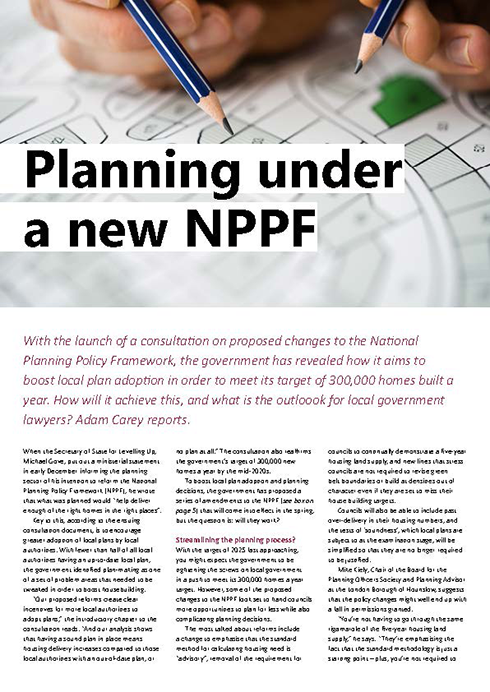Planning under a new NPPF
- Details

With the launch of a consultation on proposed changes to the National Planning Policy Framework, the government has revealed how it aims to boost local plan adoption in order to meet its target of 300,000 homes built a year. How will it achieve this, and what is the outlook for local government lawyers? Adam Carey reports.
|
To view or download this article in pdf form please click here |
When the Secretary of State for Levelling Up, Michael Gove, put out a ministerial statement in early December informing the planning sector of his intention to reform the National Planning Policy Framework (NPPF), he wrote that what was planned would “help deliver enough of the right homes in the right places”.
Key to this, according to the ensuing consultation document, is to encourage greater adoption of local plans by local authorities. With fewer than half of all local authorities having an up-to-date local plan, the government identified plan-making as one of a set of problem areas that needed to be tweaked in order to boost housebuilding.
“Our proposed reforms create clear incentives for more local authorities to adopt plans,” the introductory chapter to the consultation reads. “And our analysis shows that having a sound plan in place means housing delivery increases compared to those local authorities with an out-of-date plan, or no plan at all.” The consultation also reaffirms the government’s target of 300,000 new homes a year by the mid-2020s.
To boost local plan adoption and planning decisions, the government has proposed a series of amendments to the NPPF (see dropdown below) that will come into effect in the spring, but the question is: will they work?
Key measures in the Department for Levelling Up, Housing and Communities’ consultation, Levelling-up and Regeneration Bill: reforms to national planning policy (which only applies to England), include:
- Removal of the requirement for local authorities with an up-to-date plan to demonstrate continually a deliverable 5-year housing land supply.
- Removal of the 5-year housing land supply buffers (of 5%, 10% or 20%) from national planning policy in the future.
- The position on oversupply to be brought in line with that on undersupply, when calculating a 5-year housing land supply.
- Additional protections for neighbourhood plans in circumstances where a local planning authority’s policies for the area covered by the neighbourhood plan are out-of-date. This includes a proposal to extend protection to neighbourhood plans that are up to 5 years old instead of the current 2 years.
It will be made clearer in the NPPF that the outcome of the standard method is an advisory starting-point to inform plan-making – “a guide that is not mandatory”. - More explicit indications will be given in planning guidance of the types of local characteristics which may justify the use of an alternative method.
- It will be made clear that if housing need can be met only by building at densities which would be significantly out-of-character with the existing area (taking into account the principles in local design guides or codes), this may be an adverse impact which could outweigh the benefits of meeting need in full.
- It will be made clear that local planning authorities are not required to review and alter green belt boundaries if this would be the only way of meeting need in full (although authorities would still have the ability to review and alter green belt boundaries if they wish, if they can demonstrate that exceptional circumstances exist).
- It will be made clear that authorities may take past ‘over-delivery’ into account, such that if permissions that have been granted exceed the provision made in the existing plan, that surplus may be deducted from what needs to be provided in the new plan.
- The tests of ‘soundness’ through which plans are examined will be amended and simplified, so that they are no longer required to be ‘justified’. Instead, the examination would assess whether the local planning authority’s proposed target meets need so far as possible, takes into account other policies in the Framework, and will be effective and deliverable.
- The changes to the test of soundness will not apply to plans that have reached pre-submission consultation stage, plans that reach that stage within 3 months of the introduction of this policy change, or plans that have been submitted for independent examination.
- The government intends to maintain the “urban uplift” amended in 2020 and to require that this is, so far as possible, met by the towns and cities concerned rather than exported to surrounding areas. The Levelling Up and Regeneration Bill will remove the Duty to Co-operate, although it will remain in place until those provisions come into effect.
- An additional permissions-based test will be added to the current Housing Delivery Test. This will ‘switch off’ the application of ‘the presumption’ in favour of sustainable development as a consequence of under-delivery, where a local planning authority can demonstrate that there are ‘sufficient’ deliverable permissions to meet the housing requirement set out in its local plan. The LPA will need to have permitted 115% of its local housing need for the switch off to apply.
- The NPPF will be changed to make clear that local planning authorities should give greater importance in planning for Social Rent homes, when addressing their overall housing requirements in their development plan and making planning decisions.
- The government will explore whether past irresponsible planning behaviour should be taken into account when applying for planning permission. The consultation sets out two potential ways in which this might be done, by either: making such behaviour a material consideration when local planning authorities determine planning applications; or allowing local planning authorities to decline to determine applications submitted by applicants who have a demonstrated track record of past irresponsible behaviour prior to the application being considered on its planning merits.
- Three further measures will be introduced, via changes to national planning policy, to help incentivise developers to build out more quickly. These are: publishing data on developers of sites over a certain size in cases where they fail to build out according to their commitments; requiring developers to explain how they propose to increase the diversity of housing tenures to maximise a development scheme’s absorption rate; the NPPF will highlight that delivery can be a material consideration in planning applications.
- The NPPF will be changed to emphasise the role of beauty and placemaking in strategic policies. A stronger link will be made between good design and beauty.
- The Framework will be amended to encourage local planning authorities to consider how they can ensure that planning conditions associated with applications reference clear and accurate plans and drawings which provide visual clarity about the design of development, as well as clear conditions about the use of materials where appropriate, so they can be referred to as part of the enforcement process.
- Further measures on: delivering biodiversity net gain and local nature recovery; recognising the food production value of farmland; climate change mitigation: exploring a form of carbon assessment; climate adaptation and flood-risk management; onshore wind and energy efficiency.
- Plan makers are to be given 30 June 2025 to submit their local plans, neighbourhood plans, minerals and waste plans, and spatial development strategies for independent examination under the existing legal framework; this will mean that existing legal requirements and duties, for example the Duty to Cooperate, will still apply. There is also a proposal that all independent examinations of local plans, minerals and waste plans and spatial development strategies must be concluded, with plans adopted, by 31 December 2026.
- Proposals for the scope and principles behind National Development Management Policies, which, amongst other things, are intended to help local authorities produce swifter, slimmer plans by removing the need to set out generic issues of national importance such as policies for protecting the green belt.
Streamlining the planning process?
With the target of 2025 fast approaching, you might expect the government to be tightening the screws on local government in a push to meet its 300,000 homes a year goal. However, some of the proposed changes to the NPPF look set to hand councils more opportunities to plan for less while also complicating planning decisions.
The most talked about reforms include a change to emphasise that the standard method for calculating housing need is “advisory”, removal of the requirement for councils to continually demonstrate a five-year housing land supply, and new lines that stress councils are not required to revise green belt boundaries or build at densities out of character even if they are set to miss their house building targets.
Councils will also be able to include past over-delivery in their housing numbers, and the tests of ‘soundness’, which local plans are subject to at the examination stage, will be simplified so that they are no longer required to be justified.
Mike Kiely, Chair of the Board for the Planning Officers Society and Planning Advisor at the London Borough of Hounslow, suggests that the policy changes might well end up with a fall in permissions granted.
“You’re not having to go through the same rigamarole of the five-year housing land supply,” he says. “They’re emphasising the fact that the standard methodology is just a starting point – plus, you’re not required to build in the green belt, so this is inevitably going to result in even smaller numbers of sites being allocated in plans.”
Kiely is not alone in his reading of the proposals, with some lawyers also predicting a drop in housebuilding as a result of the changes.
Some also cautioned that certain changes would further expose the planning process to litigation, stymieing planning decisions, protracting the local plan-making process, and ultimately reducing housebuilding.
One such change is the guidance that councils will not need to plan to meet their housing needs where it would mean building at densities significantly out of character with the existing area. “How do you define ‘out of character’?” queries Simon Ricketts, a partner at specialist planning law firm Town Legal.
Meanwhile, Kiely identifies the change as something that councillors will employ to reject applications. “It’s a simple phrase that local communities and members will latch on to without actually saying what they mean,” he says.
Kiely notes that such objections currently get exposed at appeal, “whereas [under the proposed changes] I think they’re going to be even more encouraged, more confident to say that without really thinking what they mean, and I think we’re just going to result in more [applications] being refused.”
Lengthy arguments will also play out over the amendment that emphasises that the standard method for calculating housing need is an “advisory starting point,” lawyers warn.
On this point, Cornerstone Barristers’ Dr Ashley Bowes says that the reform would “create more uncertainty and delay” as the ‘advisory starting point’ will herald new approaches to calculating housing need.
This change will not only allow planning authorities to produce their own “self-serving” methodologies, “which may not put so much weight on affordability uplift, and so produce a lower figure,” Dr es says, but will also take planning authorities back to a pre-2018 world – before the standard method was introduced – where numbers were argued over at great length.
Dr Sue Chadwick, strategic planning advisor at Pinsent Masons, who has spent more than two decades working in planning law at local authorities, private firms and in academia, also envisages a more combative planning system under the change.
“My worry is that, by saying it’s advisory […] rather than having two or three parties arguing about what the standard method means, you might have two or three parties each with their own method,” she says. “In which case, that’s not going to make money for anybody, except potentially private sector, lawyers and planners.”
(Main article continues below)
|
What does this all mean for local government lawyers? “I think what is proposed will be really helpful, actually, in terms of the flexibilities,” Rachel McKoy, Vice President of Lawyers in Local Government, says. McKoy has spent her career as a place law specialist in a number of local authority legal departments. She was a senior planning solicitor at Southwark for a decade before joining Bracknell Forest Council as Assistant Borough Solicitor (Place) in 2015. She has taken on increasingly high-profile roles since then and is currently Director of Law & Governance (Monitoring Officer) at the London Borough of Hounslow. Commenting on the NPPF consultation, McKoy laments the resource problems facing local authorities and the government’s “constant tinkering with the planning process”, but she largely sees the changes to be positive. Data from the Local Government Association published last month (January 2023) backs up McKoy’s point, showing that planning officers are the most difficult professionals to recruit after social workers, with 58% of local authorities reporting difficulties. “That has a direct implication for the lawyers that facilitate those instructions,” McKoy notes, “but in terms of practicalities, I think what’s proposed will be really helpful.” She singles out changes to the standard method for housing delivery, greater clarity on planning in the green belt, and the ability for councils to count past over-delivery in their delivery numbers as welcome reforms. McKoy sees the inclusion of past housing over delivery as a plus, noting that councils will be able to avoid falling foul of underdelivering one year despite exceeding housing targets in the years before – an issue she experienced “quite markedly” at Tower Hamlets. “We were always the darlings of the Greater London Assembly because of the amount of housing [we delivered], but then one little blip [and the council would lose an appeal],” she bemoans. Making the standard method advisory will also be an appreciated change for local government, according to McKoy, as it means councils will be able to respond to “what’s happening on the ground” instead of being confined by housing targets. “For those boroughs that are going through growth, [that change is] going to be really exciting as they will be able to go over and above,” she says. McKoy adds that the proposals to allow councils to scrutinise poorly performing developers would complement growing authorities, as developers can often be a barrier in pushing through a corporate plan for growth. She described a bugbear situation in which developers “get their permission, and they just sit there and they’re on integral schemes and you’re at their beck and call to a certain extent because [they’re] integral to the development of a town centre.” “So I think that would be good because there are serial offenders in this world, and that’s what they do,” she notes. When asked about the critiques of the proposed measures that suggest developers can avoid scrutiny through buying land that already has permission, McKoy replies: “These things are about intentions, and it’s about signalling from government as well – just recognising that yes, this does happen a lot because quite often, from the local government perspective, in the planning space, we always get a bit bashed. “It’s always, ‘oh planning departments halt development, they sit on applications, are slow and bureaucratic, and x, y and z’, when that’s not always the story on the ground because things are progressed, but developers just sit on it because that suits them.” Despite the positives, McKoy recognises the uncertainty that the changes bring for local plan-making. “It’s really messy at the moment in terms of what we do. Do we carry on with our local plans? Do we pause them? What does it all mean?” And the uncertainty is impacting morale in already stretched legal and planning departments, she acknowledges. But she stays optimistic: “Let’s remain positive about our trajectory, what we can achieve locally through that central support. Let’s find solutions. Let’s get things moving and just deliver for our communities. “So whatever tools and whatever changes can help that [through] flexibilities that are pragmatic and, at a local level, mean something and translate into common sense changes on the ground, then I’m all for it.” |
The immediate impact
While Drs Chadwick and Bowes predict a future beset with delays over housing numbers spats, one proposed amendment to the NPPF is already delaying planning.
In the wake of Gove’s ministerial statement and the publication of the consultation, seven local authorities moved to pause their local plans, with many citing the changes to revising the green belt as to why.
Isle of Wight Council became the latest council to pause its plan in late January, following decisions at South Staffordshire Council, North Somerset Council, Stockport Metropolitan Borough Council, Horsham District Council, Teignbridge District Council and Mole Valley District Council to pause their local plans, in light of the NPPF consultation.
Councillors at Mole Valley, which currently has a draft local plan at the examination stage, asked their inspector to remove all green belt sites from the draft plan, a modification which would see 1,476 fewer homes delivered in Mole Valley’s area over the plan period.
“Authorities are thinking: ‘why are we continuing on a track to arrive at a plan which is likely to be locally unpopular because it is planning for a high number of homes to be built potentially in green fields areas not popular with our voters when we could potentially plan for less’,” Ricketts explains.
Paused local plans have a measurable impact on housing delivery, with analysis from leading planning consultancy Lichfields showing that as many as 11,200 homes per annum will be lost as a result of the 28 local plans that are currently paused (the majority of which were stalled before the proposed changes to the NPPF were announced) – a potential blow to the government’s 300,000 homes a year aim.
(Main article continues below)
|
New avenues for litigation One thing is for certain, the full impact of the changes will not be understood without input from the courts, and there are a few areas in which lawyers predict litigation. These include the change allowing councils not to meet their housing targets if it would involve building at densities significantly out of character with the surrounding area, as the approach to defining “significant out of character” will attract debate. Councils should also tread carefully when departing from the standard method for calculating housing targets, as implementing their own methodologies will also lead to arguments, lawyers suggest. Powers for councils to scrutinise poorly performing developers, which are proposed in the changes, will also be troublesome for councils, as in situations where a third party believes a council granted planning permission to a developer with a poor track record, the third party would have the option to argue the council should have taken their performance into account. In addition, some predict that developers will inevitably challenge any refusals based on their past poor performance. |
Looking on the bright side
A handful of proposed changes will improve the planning process, according to some lawyers, so what amendments have been welcomed?
One change that received broad praise is the removal of the tests of soundness at the examination stage. The change builds on amendments to the current version of the NPPF introduced in 2021, which already watered down the tests.
“I think [the local plan process] was getting bogged down with too many inspectors expecting too much proportionate evidence to justify things,” Michael Bedford KC of Cornerstone Barristers says.
“Too many inspectors, in my view, were not really taking on board that change,” he adds, “and were expecting a local plan to achieve too high a standard of perfection before they would endorse it. So I’m wholly in favour of getting rid of that test.”
Bedford did, however, criticise the government’s plan to delay the implementation of this, meaning the change will not come into effect for any plan which is currently in the pipeline and will only apply to plans which are not at the regulation 19 stage – the stage just before submitting the plan for examination – within three months of the final NPPF being published.
Promises in the NPPF consultation to implement National Development Management Policies (NDMPs) were also met with nods of approval.
According to the consultation, the government intends for NDMPs to cover planning considerations that regularly apply in decision-making across England, which, for example, might include general policies for conserving heritage assets, and preventing inappropriate development in the green belt and areas of high flood risk.
Making a case for NDMPs, the consultation document claims that standardised policies will shorten local plans and will stop unnecessary time spent at examination testing whether generic development management policies are consistent with the NPPF.
“I think that is a good idea, absolutely,” Dr Bowes comments. “You don’t need 52 different policies talking about how you protect a listed building across the country, all slightly differently worded. That’s in nobody’s interest.
“It’s not in developers’ interest because they want a clear set of rules as to how they design a scheme that is likely to get planning permission, and it’s not in local councils’ interests because they might well be legally challenged on their interpretation of individual policies and they’re having to bear the individual burden rather than it being done at a national level.”
|
Lawyers say the planning system is becoming increasingly like an obstacle course. |
Added hurdles
However, Dr Chadwick worries that the promised NDMPs are an example of a bigger problem. She argues that the policies represent another addition to the burgeoning roster of future planning policy changes, spreading uncertainty in the sector – and, if implemented, will introduce yet another hurdle for planning authorities to overcome.
She jokingly compares the increasingly complicated decision-making process to a Tough Mudder, a type of foot race that sees runners tackle a series of muddy obstacles.
“When I came into planning, it was a development plan, material considerations, and it was relatively complicated then.
“And then you had the NPPF and the presumption in favour of sustainable development – so, you had another obstacle for that decision-maker to get their head around, and now we have another layer of policy to be put in [in terms of the NDMPs].
“And then, in addition, you have the proposals through the Levelling Up and Regeneration Bill saying that as well as being material, they’d have to be strongly material, and it’s like you just get over the first five hurdles, and you’ve still got to go through the mud under the barbed wire that might or might not be electrified.”
“It’s almost like they’re finding ways to make decision-making more complicated, and that doesn’t help anybody,” she concludes.
These added hurdles, as Dr Chadwick describes them, are being proposed as council planning departments are reporting significant resourcing issues, with nine in ten authorities experiencing a backlog in planning cases thanks to a £364 million drop in yearly local authority spending on planning, according to data from the Royal Town Planning Institute.
Bedford notes that many planning departments, particularly the plan-making side of planning departments, are “woefully under-resourced”.
“In a sense, it doesn’t really matter what the guidance says if you’ve still got to have people who can engage with the guidance and you haven’t got them, you can’t produce really anything useful,” he concluded.
While these obstacles are not insurmountable, they are significant, and it seems evident that it will be a reach for the government’s housebuilding targets to be met by the mid-2020s.
Just getting to grips with the changes to the NPPF will be a daunting task for councils, and in the short term, local plan adoption is going to slow amid the uncertainty.
In the long term, even once the dust has settled on the reforms, chronic resource and recruitment issues could scupper the government’s ambitions of encouraging more councils to adopt up-to-date local plans entirely.
Adam Carey is a reporter at Local Government Lawyer.
www.localgovernmentlawyer.co.uk/planning
The Department for Levelling Up, Housing and Communities consultation runs until 2 March 2023.
Sponsored articles
Unlocking legal talent
Walker Morris supports Tower Hamlets Council in first known Remediation Contribution Order application issued by local authority
Legal Director - Government and Public Sector
Lawyer (Planning and Regulatory)
Contracts Lawyer
Locums
Poll









































